As wildfires raged across Los Angeles in January, a state official parried an email from a resident living on the edge of the conflagration: When would long-delayed regulations designed to protect high-risk homes like hers be implemented?
“I do not have a timeline for you,” replied Edith Hannigan, then the executive officer of the California Board of Forestry and Fire Protection, the agency charged with drafting regulations requiring ember-resistant zones around homes. “I hope you and your loved ones are well during this fire siege.”
Related: KCC Completes Review of California Wildfire Model
With climate-driven wildfires now capable of raining flaming embers down on far away neighborhoods, scientists say removing vegetation, wood gates and other combustible material within five feet of a home to create an ember-resistant zone is one of the most effective ways to avert an urban firestorm. California in 2020 had enacted a law that mandates the establishment of such protections, called Zone Zero, in wildfire-vulnerable communities.
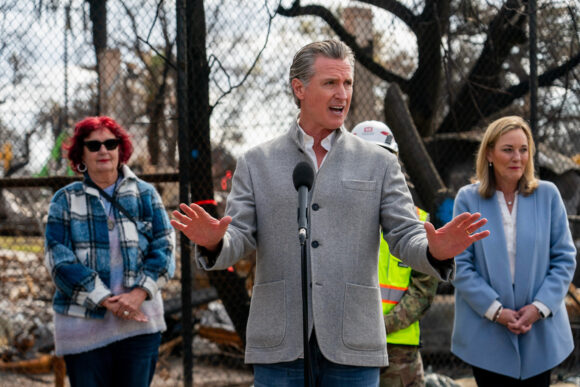
The forestry board, however, had missed a January 2023 deadline to approve regulations to put Zone Zero into force — and the rules remained in limbo when L.A. burned.
The board had balked at insurance lobbyists and fire officials’ demand for stringent protections while the governor’s office worried about the cost to homeowners, according to documents obtained by Bloomberg Green in a public records request. And from the Berkeley Hills to Beverly Hills, some homeowners resisted the prospect of removing coast live oaks, manzanitas and other beloved plants and trees in heavily-vegetated urban neighborhoods.
More than six months after the LA catastrophe, officials have yet to complete regulations as wildfires burn across the state this week. Amid a late-summer heat wave on Friday, nearly 3,000 people fled a rapidly growing blaze near Los Angeles County.
The discord over Zone Zero underscores the disconnect between accelerating climate threats and the aesthetic price Californians are prepared to pay to protect their communities. In a state particularly at risk from disasters, the political system has not always been well-suited to taking decisive action given resistance from regulators and residents who can be reluctant to adopt changes that can remake the look of their communities.
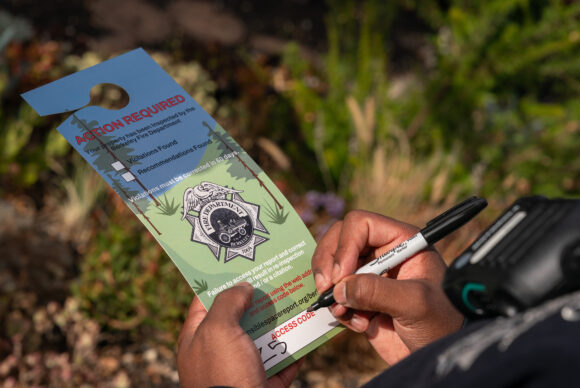
“It’s the gambler’s fallacy,” says Gabrielle Wong-Parodi, a Stanford University scientist who studies people’s decision-making in reaction to climate change. “People tend to think that if a fire just happened it’s not going to happen again, or if it hasn’t happened it’s not going to happen.”
Independent investigators who sifted through the ruins of Altadena, Pacific Palisades and other neighborhoods razed by the L.A. fires concluded that had the Zone Zero regulations been in place as the law required, they would have curtailed the destruction that resulted in the loss of some 16,000 homes and 31 lives.
“There’s no doubt in my mind that this level of damage would’ve been avoided,” says one of those investigators, Steve Hawks, senior director for wildfire at the nonprofit Insurance Institute for Business & Home Safety and a former official with Cal Fire, the state firefighting agency.
“I think that’s true but we’ll never know how much,” says California Board of Forestry chair Terrence O’Brien, who joined the organization last year.
In the aftermath of the L.A. fires, California Governor Gavin Newsom issued a Feb. 6 executive order directing the forestry board to issue initial draft regulations within 45 days, which it’s done, and adopt a final version by year’s end. But the conflicts that had stalled their enactment remain unresolved.
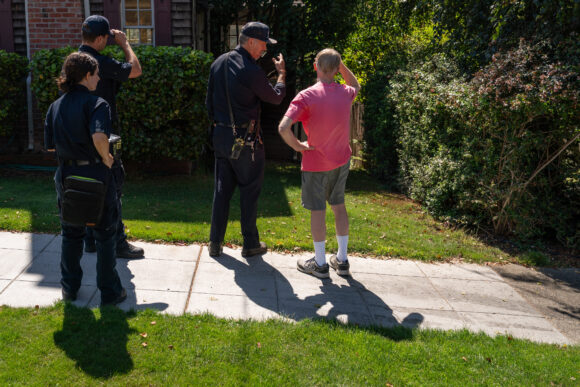
Hannigan didn’t respond to interview requests. The governor’s office referred questions about the delay in implementing Zone Zero to the California Natural Resources Agency (CNRA), which oversees the forestry board. “Developing Zone 0 regulations is a complex task,” spokesperson Kirsten Macintyre said in an email. She noted the agency had spent the past years gathering additional information on the science of ember-resistant zones, the compliance costs and financial assistance for homeowners.
“It’s a really thorny issue, so it doesn’t surprise me that before I came onboard, the board was wrestling with this issue and was having a difficult time dealing with it,” says O’Brien.
“This was the new reality”
For more than a century California wildfires regularly burned in the state’s heavily-forested hinterlands while urban infernos were a once-in-a-generation phenomenon. Hollywood stars lost their homes in the 1961 Bel Air wildfire in L.A. and the 1991 Oakland-Berkeley Hills firestorm destroyed 3,000 homes and killed 25 people. Nearly another 30 years passed before the 2017 Tubbs Fire, when embers carried by near hurricane-force winds from a fast-moving Wine Country wildfire ignited a suburban Santa Rosa neighborhood called Coffey Park.
“You didn’t immediately see the insurance industry react to that because there had been nothing since 1991 and maybe Coffey Park was a one-off thing,” says Seren Taylor, vice president of the Personal Insurance Federation of California, a lobbying group for the state’s major carriers. Then the next year the Camp Fire incinerated more than 18,000 homes in the Sierra Nevada foothills community of Paradise and 85 residents died. “Wildfire had not been perceived as a top-tier threat like an earthquake but now it was obvious that this was the new reality,” he says.
As experts scrambled to study rapidly changing wildfire behavior and how homes caught fire, they determined that two strategies would be most effective at protecting neighborhoods. One was to harden homes against wildfire by installing fire-resistant roofs and exterior siding along with tempered double-paned windows and mesh screens over vents to prevent flying embers from entering a dwelling. (California law requires houses constructed after 2008 in high-risk wildfire zones be hardened but the mandate doesn’t apply to older homes in those areas, which constitute the vast majority of the housing stock in California.)
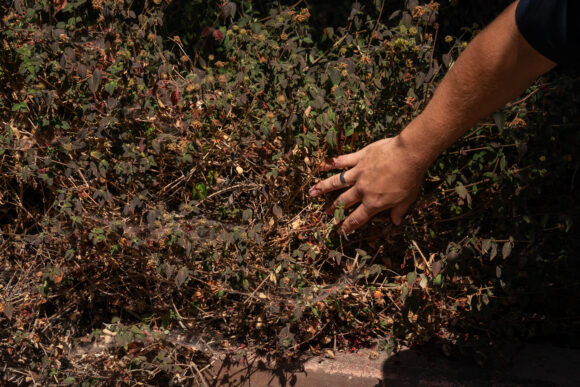
The second was to build what amounts to a nonflammable moat around a home to prevent embers from alighting on anything next to a house that could burn and ignite the structure. Of particular concern are wood gates and fences attached to a home since once lit by embers they burn like a fuse to a bomb.
Related: Newsom Seeks $18B for Utilities’ Wildfire Fund as California Faces Future Blazes
Scientists who have analyzed data on 47,000 structures destroyed or damaged in five California wildfires between 2017 and 2020 and examined satellite imagery of surrounding vegetation, projected that Zone Zero would nearly double home survival rates. “Doing this on a community level dramatically reduces risk,” Michael Gollner, a University of California at Berkeley fire scientist and one of the researchers, recently told the forestry board.
On the morning of Sept. 9, 2020, the skies over the San Francisco Bay Area turned an apocalyptic orange from the smoke of 20 large wildfires burning across Northern California. Less than two weeks later, Newsom signed into law legislation mandating the establishment of ember-resistant zones in areas designated as a “very high fire hazard severity zone.” The forestry board had until Jan. 1, 2023 to issue regulations.
“Out of step” with the science
By October 2022, that deadline seemed within reach. The draft of proposed regulations was under review by the governor’s office with the expectation that they would be adopted in a few months’ time, according to forestry board staff emails.
Crafted with the input of scientists, fire officials, insurance industry representatives and members of the public, the draft, however, still allowed for grass lawns, ground cover and small plants within five feet of a home. “The board, at the time, made it very clear that they did not support a noncombustible zone and wouldn’t vote for one,” Hannigan, then the executive officer, recounted in a February 2025 email sent to current board chair O’Brien the day after Newsom’s order to finalize the regulations.
Insurance lobbyists had warned the board in a letter that the 2022 draft regulations were too lax, “out of step” with wildfire science and would endanger high-risk communities. The Office of the State Fire Marshall also objected on similar grounds. Both took their concerns to the governor’s office, according to forestry board documents.
Homeowners, meanwhile, were raising red flags about the potential cost of complying with Zone Zero. “It will be extremely expensive and unaffordable for thousands of homeowners,” wrote a resident of Rancho Palos Verdes in Los Angeles County to the forestry board in April 2023. The California Natural Resources Agency, which is in charge of the forestry board, also expressed concerns over the board’s estimate that it would cost homeowners nearly $58 million to comply with the proposed regulations.
Insured losses from January’s LA wildfires, on the other hand, could reach $45 billion, according to University of California at Los Angeles researchers.
“There’s a huge disparity there between what the cost of Zone Zero may be and what happens if you have a catastrophic wildfire,” says O’Brien.
Nevertheless, in August 2023, CNRA officials put the regulations on hold. In her email to O’Brien, Hannigan said the CNRA and the governor’s office spent most of 2024 trying to find funding “that could alleviate that burden on homeowners.” Work on the regulations, she told O’Brien, was expected to be “resurrected” in 2025. Then came the LA firestorms.
“We have to live differently”
Since the January wildfires, the forestry board has held workshops to gather public input on Zone Zero, issuing updated draft regulations almost monthly.
“It comes down to, how much of the science can we ignore in order to get buy-in from the public,” says Taylor, the insurance lobbyist.
There’s some 2 million homes in high-risk wildfire areas subject to Zone Zero located in ecosystems that range from mountain woodland hamlets to lushly landscaped coastal cities. Some are on acres of land, others sit within feet of their neighbors. All homeowners, though, could be required to establish the same ember-resistant zones around their dwellings.
Firefighters and insurance executives continue to press for a strictly noncombustible Zone Zero, warning that vulnerable communities otherwise will become increasingly uninsurable and risk destruction from urban firestorms. In comments at workshops and emails to the forestry board, though, some homeowners, particularly those on fixed incomes, detailed their worries about the cost of compliance and resisted the loss of greenery and privacy, particularly in neighborhoods where just a few feet separate houses.
Even for some Angelenos whose neighborhoods nearly burned in the January wildfires, Zone Zero crosses a line of beauty they can’t accept. “It’s going to be devastating, there will be no birds, it will be hotter,” a resident of Brentwood, an affluent and verdant enclave adjacent to Pacific Palisades, said at an April forestry board meeting.
The latest draft regulations require wood gates and vegetation to be removed from Zone Zero with the exception of small plants in noncombustible pots and well-pruned trees. Once adopted, the regulations apply to new construction but owners of existing homes have three years to comply.
“The frank reality,” says Yana Valachovic, a University of California wildfire scientist closely involved with the regulations’ development, “is that we have to live differently in California.”
Top photo: An aerial view of homes that burned in the Eaton Fire in Altadena, California. Photographer: Mario Tama/Getty Images.
Was this article valuable?
Here are more articles you may enjoy.


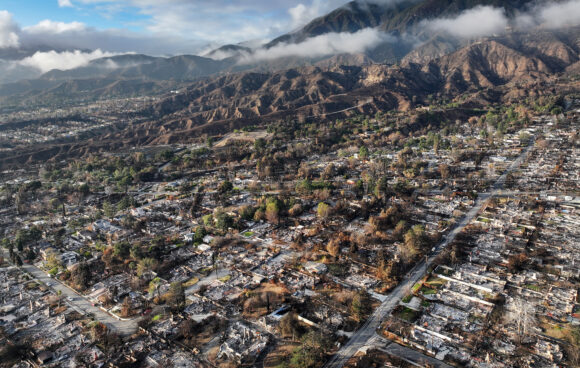
 Howden Buys M&A Insurance Broker Atlantic Group in US Expansion
Howden Buys M&A Insurance Broker Atlantic Group in US Expansion 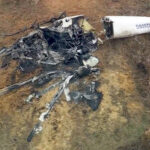 2 New Jersey Pilots Killed in Helicopter Collision Frequented Nearby Cafe Together
2 New Jersey Pilots Killed in Helicopter Collision Frequented Nearby Cafe Together  Aon Extends Employment Agreement With CEO Case
Aon Extends Employment Agreement With CEO Case 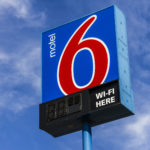 Longtime Motel 6 Spokesman Tom Bodett Settles Lawsuit Against Chain
Longtime Motel 6 Spokesman Tom Bodett Settles Lawsuit Against Chain 

